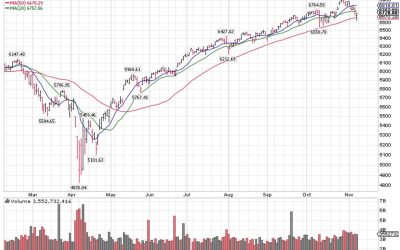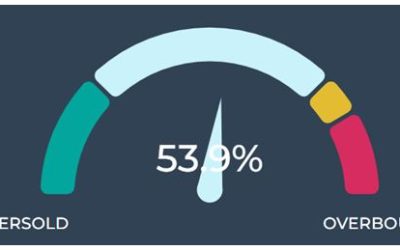by Louis Navellier
November 11, 2025
I live fairly close to Mar-a-Lago in Florida, and we recently attended a Great Gatsby party there. I will admit that it was a bit over the top, with a massive celebration of the market and “AI,” which President Trump thoroughly supports. He never seems to wear out. Around midnight, when we wanted to leave, our Commander in Chief was still going strong. Unlike his predecessor, he apparently needs very little sleep.
The Mar-a-Lago gathering celebrated a similar economic boom now unfolding – but not every stock will participate! It is imperative we own good stocks leading the AI and data-center boom, like Bloom Energy, as well as companies benefiting from AI’s productivity boom. This new Roaring ‘20s scenario is similar to Ed Yardeni’s description of today’s Roaring ‘20s market, a bit like the 1920s, in the “Great Gatsby” era.
The good news is that many of our growth stocks continue to announce wave after wave of positive third-quarter results. Although last week witnessed a “bear raid” on some AI leaders, November is historically a strong month, so I expect an early “January effect” to spark a rally before Thanksgiving! This should help set the stage for a strong year-end rally as well as a great start for the New Year. I should add that the holidays are a happy time of year, as rising consumer sentiment also helps boost investor sentiment.
In looking over our portfolios, I remain amazed that our average small-to-mid capitalization stock is currently trading at only 3.4 times forecasted earnings – a small fraction of the overall market’s P/E (around 20) – as many of our stocks remain grossly undervalued compared to some of the popular large capitalization stocks, so get ready for some more upside surprises between now and Thanksgiving.
I am proud that Nvidia and Palantir Technologies are among our largest holdings. Despite the growing evidence that AI and data centers are dominating explosive GDP growth, the efficiency and productivity gains that are being implemented should also help many companies boost their underlying profitability.
Nvidia won’t report earnings until November 19, but The Financial Times reported that Nvidia’s CEO Jensen Huang warned that China could beat the U.S. in the artificial intelligence race due to lower energy costs and less regulation. Huang’s concern about China is part of why Nvidia has a Shanghai office and wants to expand its presence in China. At a Financial Times “Future of AI Summit,” Huang warned that new AI rules by many of our 50 states could result in “50 new regulations” here at home. Clearly, Jensen Huang wants the Trump administration to help it with regulations and to get these states out of its way.
Speaking of China, their exports dropped 1.1% in October, due largely to a 25% drop in exports to the U.S. Excluding the U.S., Chinese exports rose 3.1% in October, so now that Presidents Xi and Trump have reached an agreement on tariffs, it will be interesting to see how Chinese exports rebound in November. October was the first drop in Chinese exports since February and appears to be an anomaly.
Turning to Tesla, its shareholders voted – with a whopping 75% approval rate – to provide Elon Musk with a $1 trillion pay package, but for Musk to earn his $1 trillion pay package, he will have to enrich Tesla shareholders by expanding the company’s valuation six-fold to $8.5 trillion and boosting earnings 24-fold to $400 billion, so I expect a lot of hype about Robotaxis and Optimus robots in the upcoming years, so Elon can achieve the most lucrative executive pay package ever approved by shareholders!
The fact of the matter is we are now in the midst of the strongest earnings announcement season in the past four years and earnings momentum is accelerating despite a federal government shutdown, which mostly concerns healthcare spending cuts. Frankly, even though I expect this federal government shutdown to end soon, economic productivity is actually rising during the shut-down.
Other positive news is that trillions of dollars in on-shoring for data centers, automotive, pharmaceutical and semiconductor industries, is pouring in; this on-shoring is expected to result in a massive economic boom that could fuel an annual GDP growth of 5% in 2026. Since small to mid-capitalization stocks are predominately domestic companies, they should prosper during this accelerating economic boom.
This coming GDP growth is one reason why the “Roaring ‘20s” scenario could well unfold over the next few years. We are now in the midst of accelerating GDP growth with fewer workers, resulting in soaring productivity gains. In the meantime, since inflation is contained and the Fed has an unemployment mandate, I am expecting more Fed key interest rate cuts, including one at its December FOMC meeting.
We are now in a brave new world of technological change. Just like the late 1990s Internet boom, which created a record stock market surge, AI and data centers are creating a new boom. Right now, it feels like we are back in 1996. When that boom reached its peak, in 1999, it delivered my best performing year, in which I had multiple small- and mid-capitalization portfolios up over 100%! In summary, this is the time to be “locked and load” with great stocks, so prepare for a strong year-end rally and a spectacular 2026!
The Latest Economic Data is “Mixed,” But Faster Growth is Coming Soon
If you look only at the weekly data, you might miss the big picture about America’s economic boom. For instance, the Atlanta Fed recently revised its third-quarter GDP estimate up to a +4% annual pace.
Graphs are for illustrative and discussion purposes only. Please read important disclosures at the end of this commentary.
I realize that the productivity boom is also displacing a lot of jobs, but that also boosts corporate earnings and GDP growth. Jason Furman, a Harvard Economics professor who was previously in the Biden administration, reported, excluding data centers, the U.S. only had 0.1% GDP growth in the first half of 2025. In other words, data centers and AI are accounting for almost all of U.S. GDP growth.
The current news doesn’t seem all that rosy at first look, but we are not receiving some of the major federal government statistical series on a timely basis. We have to rely on private services, such as the Institute of Supply Management (ISM), which recently announced its manufacturing index declined to 48.7 in October, down from 49.1 in September. This is the eighth consecutive month the ISM manufacturing index has been below 50, which signals a contraction. Only six 6 of the 18 industries reported expansion.
However, the U.S. service economy is much larger than our manufacturing economy, so it’s encouraging that ISM also announced its service index rose to 52.4 in October, up from 50 in September, in the biggest monthly increase in the ISM service index since February. The business activity component surged to 54.3 in October, up from 49.9 in September. Also, the new orders component soared to 56.2 in October, up from 50.4 in September – reaching its highest level in the past 12 months. Also, 11 of the 17 service industries surveyed reported an expansion in October, up from 10 industries in September.
Also, ADP announced on Wednesday that 42,000 private payroll jobs were created in October, which was better than the economists’ consensus estimate of 30,000. This was the first monthly increase in private sector jobs in three months. Nela Richardson, chief economist at ADP, said, “The recovery is tepid and not broad based,” so obviously the Fed needs to keep cutting key interest rates to stimulate the job market.
Interestingly, there is a severe correction in cryptocurrencies underway, which is great news for our gold stocks, since some cryptocurrency investors are clearly shifting to gold. Bitcoin fell below $100,000 for the first time since mid-June and it is now down 20% from its record high of $126,272 on October 6th.
The coming U.S. economic boom is not expected to be inflationary, since the U.S. dollar is firming up and starting to offset any impact of tariffs on imports. Furthermore, China remains in a deflationary environment, and we are importing some of their deflation. Shrinking households throughout Asia and Europe have caused economic stagnation and deflation. Furthermore, the European Union’s (EU) Net Zero goals have caused energy costs to soar and are systematically destroying manufacturing industries.
In the U.S., we largely eliminated carbon taxes, are energy independent and poised to benefit from overseas companies coming to America to escape oppressive rules and regulations. For example, Stellantis is boosting its investment in America due to the fact that the EU wants to fine it $2.95-billion for carbon emissions, so it has a big incentive to move some of its manufacturing to America. The fact that our 50-states compete with one another to attract this on-shoring which is unfolding is also very positive.
The net result is that America has resumed leading the world, partly by not conforming to Net Zero and other initiatives that the European Union (EU) and the Davos crowd have pushed. Demographics are also systematically destroying Asian and European economies due to shrinking household formations. This is accelerating the capital flight to America that President Trump has encouraged with his tariffs.
In America, we are still pro-family (especially in the Mountain West and South), creating new households that naturally boost economic growth. Furthermore, America also assimilates immigrants, unlike Britain, France and Germany, but naturally the Trump administration wants these immigrants to be legal.
Speaking of Net Zero rules, the latest global climate summit (COP 30 in Brazil) was a bust. The U.S. was not in attendance and the Trump administration’s rejection of the Paris Climate Accord and a Net Zero goal by 2050 is effectively undermining the latest climate conference. Furthermore, since green energy is much more expensive than fossil fuels, and is hindering Britain, Germany and other major economies, the goal of lowering carbon emissions was severely watered down in the latest COP statement.
The European Union dominated the COP conference. The irony is that the host country of COP 30, Brazil, is not in compliance with any COP mandates and continues to deforest the Amazon. After clearing so many trees, the soil nutrients decay within four years, so more land needs to be cleared in the Amazon. The irony of having was COP 30 held in Brazil was obviously an insult to the Net Zero movement.
Navellier & Associates; own Nvidia (NVDA), Palantir Technologies (PLTR), Bloom Energy Corporation Class A (BE), and Amazon.com, Inc. (AMZN), in managed accounts. A few accounts own Tesla (TSLA) per client request. Louis Navellier and his family own Nvidia (NVDA), Palantir Technologies (PLTR), and Bloom Energy Corporation Class A (BE), via a Navellier managed account, and Nvidia (NVDA), and Amazon.com, Inc. (AMZN), in a personal account. They do not own Tesla (TSLA).
The post 11-11-25: Is This the Start of a “Roaring ‘20s” Market and Economy? appeared first on Navellier.








